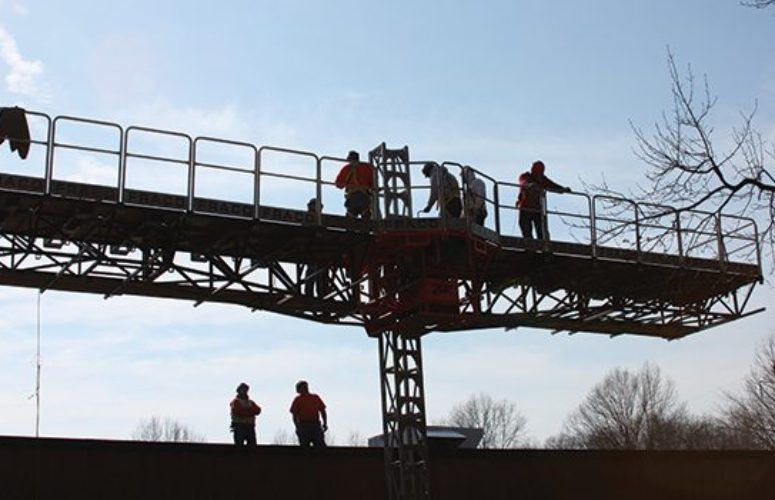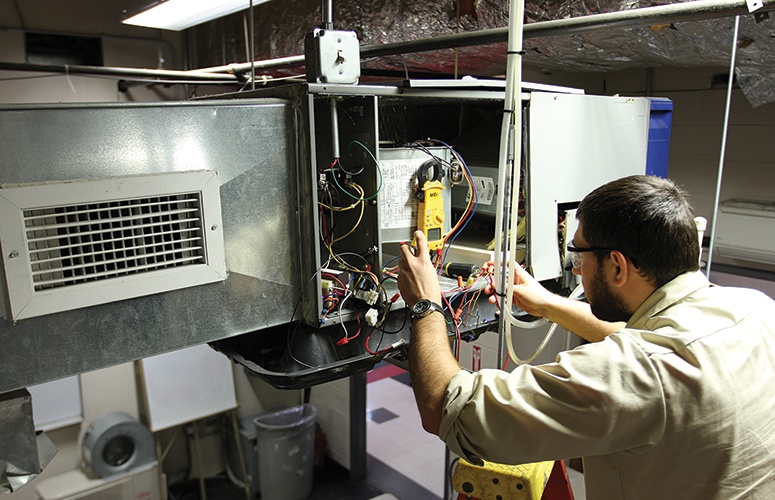
Building in New Jersey
Union training ensures a nonpariel workforce.
By Ilene Dorf Manahan, Contributing Writer On Aug 17, 2015High-tech is not a term typically used to describe the building and construction trades. But it should be, as “joy sticks” have been augmented by computers, satellite transponders and GPS, and heavy equipment operators are expected to know every aspect of their machinery. This 21st century operating environment has dramatically influenced the training requirements for union members, with some courses mandated to enter the trades and some invaluable for career enhancement.
With this emphasis on education and state-of-the-art training facilities, the ranks of New Jersey’s trades now include some 140,000 employees with: the skills needed to tackle the most difficult jobs; operate technically sophisticated equipment and systems: and knowledge about other trades’ responsibilities as they collaborate on projects, ensuring that each job is handled professionally and safely – making the state a good place to locate and grow a business.
The NJ State Building & Construction Trades Council (NJBCTC) provides resources to 15 affiliated trades unions: boilermakers, bricklayers, carpenters, electricians, elevator constructors, finishing trades, insulators, iron workers, laborers, operating engineers, operative plasters and cement masons, pipe trades, roofers, sheet metal workers and teamsters.
To maximize their training, the council and trades formed a Training Directors and Apprenticeship Coordinators Committee. While each trade delivers its own curriculum, all are monitored by the US Department of Labor, and the committee members meet quarterly to share information and ideas, with special attention to the entry level apprentice community.
“The defining difference between building trades union and non-union workers is the training our members receive,” asserts Bill Millea, the committee’s chair and a Roofers Local trainer. “We believe our apprenticeship programs are as important as going to college, as the attendees learn a trade, earn good wages plus benefits, and even can earn college credits and a degree.”
Interested prospects apply for one of a limited number of apprenticeships available in their desired trade. Upon graduation, apprentices are designated journeymen (skilled craft-workers in their respective trade).
In addition to receiving a “free education,” apprentices get paid while they learn. Shortly after apprentices begin their classroom studies, they start their on-the-job training, where they earn a percentage of the journeyman pay – a percentage that increases as the apprentice gains experience. With further education, experience and certification in such high-demand fields as green energy and LEED, journeymen can advance their careers and partner with a variety of trades.
“Our union halls are essentially empty,” reports Greg Lalevee, business manager of Local 825 Operating Engineers, whose landmark New Jersey heavy equipment training facility is visible from the New Jersey Turnpike in South Brunswick. “Virtually any member seeking work is working – especially heavy equipment and crane operators with added technical skills, since the equipment is sophisticated and certifications are often required.”
Equipment cross-training makes these professionals even more valuable, as it enables them to collaborate with other trades on a job site. To provide this training, Locals partner with contractors and vendors who deliver their advanced equipment to training sites when it’s not needed, so workers can learn to operate it.
“When we announce that we’ll be distributing applications for our current ‘class’ of apprentices, hundreds line up for them,” Lalevee reports, “but not everyone can make it. Many claim they’re qualified for trade work, but when we send them for training, we learn they’re not.”
It’s also not easy work, Millea adds. Operators often have to drive the multi-axle trucks carrying their heavy equipment to job sites, unload the machinery and work on the site all day before reloading the equipment onto the truck and returning home. Others are challenged by the technology. As a roofer himself, Millea knows that working on a roof in 125-degree weather also can be a deterrent. “Doing that day after day can be grueling, but it also can be very rewarding, especially for those who really like what they do.”
The Laborers’ International Union of North America (LIUNA) construction union works with New Jersey employers in commercial and residential building, heavy and highway construction, energy conservation/green technologies and environmental remediation. Other union members work in healthcare, public works and education.
LIUNA staffs training facilities in Folsom, which recently reopened after a multi-million-dollar renovation, Aberdeen and Jamesburg. It also has mobile units that bring training to worksites at employers’ requests. Its training funds, governed by a joint board of labor and management representatives, provide comprehensive safety and skills training that enables laborers to remain competitive.
“Training helps drive worker productivity and safety, which help drive successful projects,” asserts LIUNA Vice President and Eastern Regional Manager Raymond Pocino. “In addition to promoting quality construction, training also helps lower costs by ensuring jobs are completed on-time and on-budget.”
Working with public officials in Camden, Jersey City and Newark, LIUNA has developed a singular apprenticeship program to train local residents for construction careers. These new members are being employed on projects in their own communities and can earn journey worker status.
The Northern New Jersey Chapter of NECA, the National Electrical Contractors Association, the trade group representing the electrical construction industry of power, light and communication technology contractors, partners with IBEW Locals 102 (Parsippany), 164 (Paramus), 400 (Wall) and 456 (North Brunswick) to jointly administer their training programs.
“Most people think of management and labor as adversaries and might be surprised to learn that we collaborate in any way,” muses Eric Sivertsen, NECA’s Northern New Jersey Chapter executive director. “That cooperation is at the heart of our relationship and is particularly evident when it comes to training because we all recognize how critical it is to the ability of signatory contractors and IBEW electricians to deliver top quality performance to construction users.”
At its 16,000-square-foot Joint Apprenticeship Training Center (JATC) in Parsippany, IBEW Local 102 supplements its core training and certification courses with its Hazard Responder program, developed in partnership with JCP&L following Superstorm Sandy to help address both infrastructure repair response and public safety. As “first responders” for JCP&L, Local 102 electricians can be deployed to areas of reported damage, cordon off the area, assess the damage and report back to JCP&L, so repairs can be expedited, and monitor the area until the repair crew arrives. Local 102 also has an agreement with Union County College that enables members to earn an associate’s degree through the Local’s five-year training program.
“As New Jersey organizations, we need to forge partnerships that deliver the sector-specific training needed to keep the state fertile for business,” maintains Local 102 President Bernard Corrigan. “That includes keeping up with electrical code changes and updated safety regulations and identifying the skills required by employers. Our locals are committed to this process.”
Ongoing training also enables journeypersons to be more productive at major construction jobsites “in such surging economic areas as the Meadowlands, Jersey City and Newark, where highly skilled electrical workers are in constant demand,” states IBEW Local 164 training director Richard Paredes. “This allows members and signatory contractors to update and maintain their certifications for a competitive edge.”
IBEW workers “also show pride in their work,” adds Michael McLaughlin, president of Local 456, “which is essential when working at schools, hospitals and industrial/commercial sites that feed our economy. Shoddy workmanship not only can endanger lives, property and workplaces, but productive and safe employees also ensure customers have top quality finished products and excellent value for each dollar they invest in building and construction services.”
The Carpenter Contractor Trust of NY and NJ (CCTNYNJ) is a labor-management partnership of union carpenters and contractors that assures contractors’ needs are built into the training curricula. The Northeast Regional Council of Carpenters (NRCC), the skilled trade organization representing New Jersey and New York carpenters, under which the CCT operates, is building a new, 100,000-square-foot center in Edison.
“Whenever a large corporation or university needs to expand, one of the first considerations is whether there’s a skilled workforce in the area,” states CCT President Kevin McCabe. “We not only can deliver well-trained and certified craft people for these major developments, but with talented carpenters throughout the state, we can meet mandates that contractors engage a local workforce.”
Recognizing the growing need to protect hospital patients and staff from infection during construction, the United Brotherhood of Carpenters (UBC) offers Infection Control Risk Assessment (ICRA): Best Practices in Healthcare Construction, the accepted standard that healthcare facilities use for both their own internal infection control and for outside contractors or vendors doing construction in a healthcare facility. The course leads to the carpenters and contractors being ICRA certified.
The trades’ outreach programs help meet their needs for qualified workers. Many of their efforts are aimed at attracting minorities, women and veterans.
Through their Helmets to Hardhats program, veterans, especially those with service-related construction, engineering or heavy equipment operating experience that translates easily to operating modern equipment, can earn several months of credit and higher entry level pay for their already learned skills. Veterans also are valued for their proven work ethic.
“The construction sector in general has been under-represented by women,” acknowledges IBEW’s Corrigan. “We work hard to educate women that the building trades could be a great career path for them.” Thinking out of the box, IBEW Local 102 extended its outreach for female electricians at a battered women’s shelter, where skills training for women – now faced with supporting themselves and their children – is a priority.
The CCT has developed a unique pre-apprenticeship training program through the Puerto Rican Association for Human Development, Inc. (PRAHD) to introduce minorities to the carpentry trade and enable successful candidates to become apprentices. The prime movers behind this program were the Sisters of the Brotherhood, a part of the UBC, whose mission is to promote diversity by increasing the number of women in the carpentry trade.
“We have always supported and promoted the idea that the carpentry trades should be open to everyone interested in becoming a highly skilled craftsperson,” states Michael Capelli, NRCC executive secretary-treasurer. “This pre-apprenticeship program creates a bridge for individuals who might otherwise not have access to such an exciting, worthwhile career.”
All 15 building and construction trades participate in the state-funded Youth Transition To Work (YTTW) program, which promotes work-based learning and establishes links among schools and registered apprenticeships by bringing the experience and expertise of New Jersey tradespeople to classrooms around the state.
“We’re also out there dispelling myths about the building trades,” Lalevee adds. “Some people still think you have to be a ‘family member’ to get into the union. That’s not true. It’s definitely a ‘skill’ issue. We want every skilled operator we can get.”
Especially strong job demands for trades in New Jersey include roofing, where timely repair and replacement are critical; HVAC, with large supermarket refrigerations; ironworking, with major bridge and road infrastructure projects; heavy equipment work at urban redevelopment sites; and ongoing Superstorm Sandy recovery work, including beach replenishment.
But Lalevee suggests the “single biggest job creator” today for the state’s construction trades is the widening of the Panama Canal. Ports Newark and Elizabeth are being expanded, roads are being improved to move the anticipated greater volume of goods to market, warehouses are being built to store goods and the Bayonne Bridge is being raised to accommodate larger ships.
Nevertheless, Corrigan acknowledges, construction is a cyclical business, so “the better trained individuals are, the better chance they have to keep working,” even if that training isn’t in their primary industry. “Our extensive training results in a win-win situation. The employer gets a trained individual at no cost to them, the member is working, and the Locals forge mutually beneficial relationships.”
“Simply put, our union training is important to New Jersey’s economy as it puts money into workers’ pockets,” Millea concludes. “They make good salaries plus benefits, and have money to spend; they’re paying taxes and are not a burden to the state. At the same time, our members must be the best of the best. They must be twice as good as non-union workers. Our training programs help ensure that’s the case.”
Related Articles:






